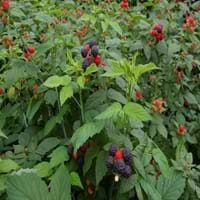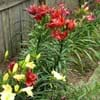Life Span
Perennial
Perennial
Type
Bulb or Corm or Tuber
Fruit
Origin
North America, Europe, Africa, Asia
Not Available
Types
White lily, orange lily, Lily of the valley
Rubus leucodermis, Rubus occidentalis, Rubus coreanus
Habitat
Not Available
Cold Regions
USDA Hardiness Zone
2-8
5-8
Sunset Zone
21,22
Not Available
Habit
Upright/Erect
Arching/Fountain-shaped
Flower Color
White, Yellow, Red, Green, Purple, Gold, Pink, Rose, Peach, Burgundy, Bronze
White
Flower Color Modifier
Bicolor
Bicolor
Fruit Color
Yellow green, Sandy Brown
Black
Leaf Color in Spring
Green, Dark Green
Green
Leaf Color in Summer
Light Green
Green
Leaf Color in Fall
Several shades of Green
Green
Leaf Color in Winter
Light Green
Light Green
Leaf Shape
Long Linear
Oval
Plant Season
Spring, Summer, Fall
Summer
Sunlight
Full Sun, Partial Sun, Partial shade
Full Sun
Type of Soil
Clay, Loam, Sand
Loam, Sand
The pH of Soil
Acidic, Neutral, Alkaline
Acidic, Neutral
Soil Drainage
Well drained
Well drained
Bloom Time
Not Available
Early Spring, Spring
Tolerances
Drought
Drought
Where to Plant?
Container, Ground, Pot
Ground
How to Plant?
Seedlings
Cuttings, Root Division
Plant Maintenance
Medium
Medium
Watering Requirements
Do Not over Water
Medium
In Summer
Lots of watering
Lots of watering
In Spring
Moderate
Moderate
In Winter
Average Water
Average Water
Soil pH
Acidic, Neutral, Alkaline
Acidic, Neutral
Soil Type
Clay, Loam, Sand
Loam, Sand
Soil Drainage Capacity
Well drained
Well drained
Sun Exposure
Full Sun, Partial Sun, Partial shade
Full Sun
Pruning
Prune in early spring, Prune in fall, Remove dead or diseased plant parts
Prune in fall, Remove damaged leaves, Remove dead branches, Remove dead leaves, Remove dead or diseased plant parts
Fertilizers
All-Purpose Liquid Fertilizer, Fertilize only when soil is poor
All-Purpose Liquid Fertilizer, Apply 10-10-10 amount
Pests and Diseases
Lily Beetle
Red blotch
Plant Tolerance
Drought
Drought
Flower Petal Number
Single
Single
Foliage Texture
Not Available
Medium
Foliage Sheen
Not Available
Matte
Attracts
Not Available
Birds, Butterflies
Allergy
Not Available
cramps, Diarrhea, Itchiness, Runny nose, Skin rash, sneezing, Swollen Lips, Tingly mouth, Vomiting, Watery eyes
Aesthetic Uses
Beautification, Showy Purposes
Not Available
Beauty Benefits
Making cosmetics
Good for skin
Environmental Uses
Not Available
Air purification, Food for birds, Food for insects, Nesting sites for birds, Shadow Tree, Windbreak
Medicinal Uses
Burns, Diuretic, Heart problems
anti-cancer, Astringent, Diuretic, Febrifuge, Stomachic, Tonic
Part of Plant Used
Whole plant
Bark, Fruits, Leaves
Other Uses
Cosmetics, Oil is used for aromatherapy, Used As Food, Used as Ornamental plant, Used for its medicinal properties
Used As Food
Used As Indoor Plant
Yes
No
Used As Outdoor Plant
Yes
Yes
Garden Design
Alpine, Container, Cutflower, Feature Plant, Mixed Border, Wildflower
Edible, Fruit / Fruit Tree
Botanical Name
LILIUM
RUBUS 'Jewel'
Common Name
Lily
Black Raspberry
In Hindi
लिली
Black Raspberry Tree
In German
Lilie
Schwarze Himbeere Baum
In French
Lis
Noir Arbre Framboise
In Spanish
Lirio
Negro del árbol de la frambuesa
In Greek
Κρίνος
Μαύρο Raspberry Δέντρο
In Portuguese
Lírio
Árvore framboesa Preto
In Polish
Lilia
Czarny Raspberry Drzewo
In Latin
lilium
Niger IDAEUS ligno
Phylum
Tracheobionta
Magnoliophyta
Class
Liliopsida
Magnoliopsida
Family
Liliaceae
Rosaceae
Clade
Angiosperms, Monocots
Angiosperms, Eudicots, Rosids
Tribe
Lilieae
Not Available
Subfamily
Lilioideae
Rosoideae
Number of Species
Not Available
Importance of Lily and Black Raspberry
Want to have the most appropriate plant for your garden? You might want to know the importance of Lily and Black Raspberry. Basically, these two plants vary in many aspects. Compare Lily and Black Raspberry as they differ in many characteristics such as their life, care, benefits, facts, etc. Every gardener must at least have the slightest clue about the plants he wants to plant in his garden. Compare their benefits, which differ in many ways like facts and uses. The medicinal use of Lily is Burns, Diuretic and Heart problems whereas of Black Raspberry is anti-cancer, Astringent, Diuretic, Febrifuge, Stomachic and Tonic. Lily has beauty benefits as follows: Making cosmetics while Black Raspberry has beauty benefits as follows: Making cosmetics.
Compare Facts of Lily vs Black Raspberry
How to choose the best garden plant for your garden depending upon its facts? Here garden plant comparison will help you to solve this query. Compare the facts of Lily vs Black Raspberry and know which one to choose. As garden plants have benefits and other uses, allergy is also a major drawback of plants for some people. Allergic reactions of Lily are Not Available whereas of Black Raspberry have cramps, Diarrhea, Itchiness, Runny nose, Skin rash, sneezing, Swollen Lips, Tingly mouth, Vomiting and Watery eyes respectively. Having a fruit bearing plant in your garden can be a plus point of your garden. Lily has no showy fruits and Black Raspberry has showy fruits. Also Lily is not flowering and Black Raspberry is not flowering . You can compare Lily and Black Raspberry facts and facts of other plants too.





